Kitsap Mountaineers History
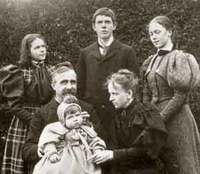 The rich history of the Mountaineers Kitsap Property began on a Spring day in 1909. A 'local walk' to view the wild blooming rhododendrons around Wildcat Lake began one of the Mountaineers Club most enduring traditions. The 'misguided' group of 66 Mountaineers wandered into Hidden Valley Ranch and met Edward Pachall and his family. A fast friendship was forged on that day. Mountaineers would return regularly to the area for the next 90+ years.
The rich history of the Mountaineers Kitsap Property began on a Spring day in 1909. A 'local walk' to view the wild blooming rhododendrons around Wildcat Lake began one of the Mountaineers Club most enduring traditions. The 'misguided' group of 66 Mountaineers wandered into Hidden Valley Ranch and met Edward Pachall and his family. A fast friendship was forged on that day. Mountaineers would return regularly to the area for the next 90+ years.
In 1915, through the efforts of Mountaineer Peter McGregor and Peter Paschall, the Mountaineers purchased 74 acres of hill land next to the Pascal Family Homestead in Hidden Valley. The 'Rhododendron Park' was intended as a place for Mountaineers to visit and enjoy and to preserve the natural beauty of the area.

Over the years, members bought tracts of property nearby for their own use and small cabins to enjoy during their visits. The park had 409 registered visitors in it's first 6 months at a time when the club boasted a membership of only 400.
The preserve grew in size over the years to almost 200 acres through member donations and property acquisition. In 1985, the Mountaineers Club transferred ownership of 170 acres to the Mountaineers Foundation for preservation and study. The club retained ownership of the 20 acres that contain Kitsap Cabin and the Forest Theater. The Foundation has since purchased buffer property and increased the size of the preserve to over 300 acres.
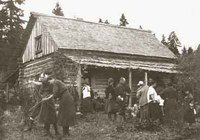
The original 74 acre purchase contained a log cabin and several outbuildings. The old Gilson farmstead (picture circa 1917) was a two-story log building that served as the original Kitsap Cabin. The men slept in the barn, the women upstairs in the old house and couples in three chicken houses. The main house was described as a "weather-beaten, decrepit relic of some early settlers losing the fight to conquer the stony soil." When the Mountaineers recognized that it wouldn't suffice for a lodge much longer, they began to seriously dream of a new cabin.
The new Kitsap cabin was constructed in 1918 during World War I. The war effort had taken away most of the men, so mostly women volunteers did the bulk of the construction work. The fireplace was designed with a niche above the mantle for a plaque honoring Mountaineers who died during the war. The niche remains empty to this day as none were killed. In the photo on the right, Ralph Lutz plays a lute in front of the stone fireplace. The famous 'empty niche' is just above his head.
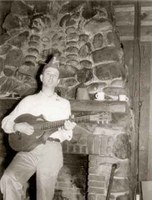
The cost of the new cabin was $600. The low cost was attributed to C.G. Morrison, a building consultant who helped the Mountaineers secure the best building materials at the best prices. It was estimated that the cabin would have cost $2,500 if all materials and labor had been purchased.
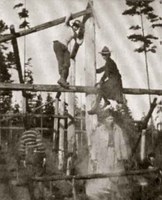
In the photo on the left, Mountaineer women volunteers are hard at work building Kitsap Cabin (circa 1918).
The new cabin, consisting of a kitchen, common area, and a large stone fire place was dedicated by Mountaineer Club president Edmund Meany on November 23, 1918, just days after the war ended. The common area of the cabin was enlarged 1927 with the help of noted architect Elsworth Story. Other than improvements of infrastructure (wiring and plumbing) the cabin remains much like it was when it was originally built.
Mountaineer Players and the Forest Theater
A prominent activity among early Mountaineer visitors involved dramatic diversions. Skits, pantomimes, kangaroo-courts, and mock-weddings were performed using props and costumes at hand. The first theatrical effort that had any continuity was a pantomime staging of the Legend of Sleepy Hollow in 1916. The headless horseman rode on a bright, moonlit Halloween night. The actors wore sheets and rode sticks with carved horses heads. The skits and performances grew into a released production of Robin of Sherwood on June 17, 1923, featuring a cast of Mountaineers (right). 
The early shows were staged in several clearings on the property. The audience moved from clearing to clearing as different scenes were presented. The performance marked the birth of the Mountaineer Players who would produce an annual show on the property every year to the present day. The only exception being 4 years during World War II.
The increasing size of the audience and the relatively uncomfortable accommodations (standing in a moist bog while swatting mosquitoes) spurred the movement to build a permanent theater facility. William C. Darling and the Players business manager, Claire McGuire, scouted the site for the Forest Theatre. The site was a level spot with a gentle upward slope near Chico Creek. 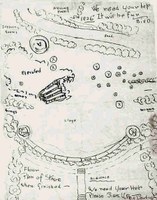
Following William C Darling's hand drawn theater design, (left, circa 1925) the Mountaineers felled trees, carved terraced seats in the hillside and lugged cedar bark from the creek bottom under Mr. Darling's direction.
The original design of the theater attempted to recreate a natural occurring glade in the forest. Trees were thinned to allow streams of light to fall on the stage while keeping the audience shaded. Kitsap Branch History photo seven Wings were constructed out of cedar bark covered with moss. Modernizations such as running water, electricity, and several buildings for storage and dressing have been added but the original design and concept remain the same. A lush row of fern footlights, bark covered wing walls with living moss and rhododendrons and dogwoods filling the back drop accent the "only real forest theater in the United States". The Forest Theater remains faithful to it's original design.
The Mountaineer Players are one of the oldest, continuously operating community theater groups in the country, performing in the one of the oldest outdoor theaters in North America. The Players pride themselves on the family-orientation of their program. It is not uncommon for several generations of families to be involved in producing the show. Several current active members have participated since the 1950's.
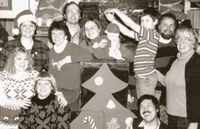
Players come in many guises. On the left is shown the cast of a Christmas Show musical review (1989).
For many Mountaineers, the Kitsap Property is a place where a work ethic still prevails and people of all ages have respect for each other and their contributions. Multi-generational friendships endure. It is hoped that the new generations will find satisfaction in play and work well done, and that theatergoers will continue to enjoy the truly unique experience of the Theater in The Wild. Theatre in the Wild: a Pictorial History of The Mountaineers Forest Theater is a wonderful telling of the history of the Rhododendron Preserve, Kitsap Cabin and the Forest Theatre. It is available for $10 at the Mountaineer Bookstore in downtown Seattle.
Mountaineers form a branch in Kitsap County in 2003
As the population on the Kitsap and Olympic Peninsulas increased, Mountaineer Player/Trustee Jamie Gordon believed a Kitsap County Branch could be sustainable. Jamie led an effort in Kitsap County that formed a branch which voted itself into existence, and elected officers on the 1st of February, 2003. The newly formed branch presented its organization to the Mountaineer Board of Trustees on the 6th of February, 2003 for consideration to be recognised formally as a branch of the Mountaineers. On March 6th, 2003, the Mountaineer Board of Trustees voted unanimously to establish a Kitsap Branch of the Club.
The Kitsap Branch teamed with the Olympic Mountain Rescue team in 2018 to establish a program center in the OMR facility in the former Westgate Community Center at 1550 Rocky Point Road NW in Bremerton, WA. This facility has allowed the Mountaineers to significantly improve its ability to train student mountaineers and provides a convenient and climate controlled facility to hold meetings and events. The program center now stands alongside the Kitsap Cabin as the home of the Kitsap Branch of the Mountaineers.